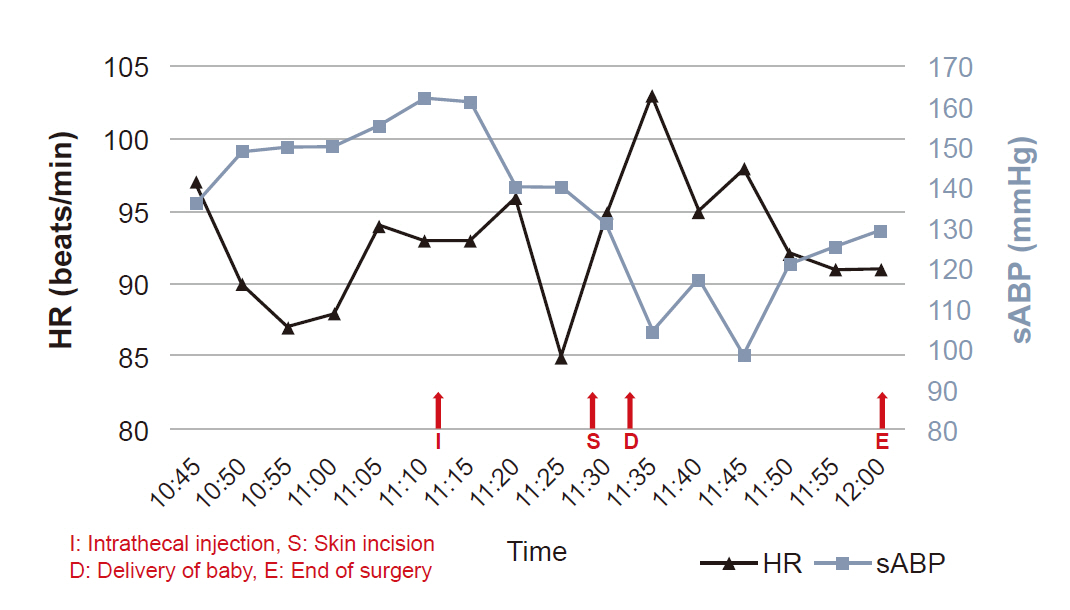Anesth Pain Med.
2020 Jul;15(3):319-324. 10.17085/apm.20009.
Spinal anesthesia for urgent Cesarean section in a patient with uncontrolled hyperthyroidism due to Graves’ disease - A case report -
- Affiliations
-
- 1Department of Anesthesiology and Pain Medicine, Dong-A University College of Medicine, Busan, Korea
- KMID: 2504894
- DOI: http://doi.org/10.17085/apm.20009
Abstract
- Background
Effective treatment of Graves’ disease during pregnancy is important because uncontrolled hyperthyroidism is associated with increased fetal and maternal morbidity and mortality. While there have been case reports of patients with Graves’ disease who failed to achieve euthyroid state during pregnancy, anesthesiologists rarely encounter patients with uncontrolled hyperthyroidism undergoing urgent Cesarean section. Case: A 31-year-old pregnant patient had uncontrolled hyperthyroidism due to Graves’ disease despite medical treatment. Her signs and symptoms suggested fetal distress and aggravation of the disease, leading to hospitalization. After a failed induction for vaginal delivery, an urgent Cesarean section was performed under spinal anesthesia via an interlaminar approach using 9 mg of 0.5% heavy bupivacaine and 20 μg of fentanyl. It resulted in successful delivery, with no perioperative complications for the mother and neonate.
Conclusions
This case demonstrates that spinal anesthesia may provide clinical stability to patients with uncontrolled hyperthyroidism undergoing urgent Cesarean section.
Figure
Reference
-
1. Devereaux D, Tewelde SZ. Hyperthyroidism and thyrotoxicosis. Emerg Med Clin North Am. 2014; 32:277–92.2. Alexander EK, Pearce EN, Brent GA, Brown RS, Chen H, Dosiou C, et al. 2017 Guidelines of the American Thyroid Association for the diagnosis and management of thyroid disease during pregnancy and the postpartum. Thyroid. 2017; 27:315–89.3. Labadzhyan A, Brent GA, Hershman JM, Leung AM. Thyrotoxicosis of pregnancy. J Clin Transl Endocrinol. 2014; 1:140–4.4. Linardi A, Michou E, Ilias I, Petychaki F, Kakoulidis I, Pappa A, et al. Resistant thyrotoxicosis due to Graves' disease in pregnancy: case report and review of the literature. Cureus. 2018; 10:e3232.5. Fleisher LA, Mythen M. Anesthetic implications of concurrent diseases. In: Miller's anesthesia. 8th ed. Edited by Miller RD, Cohen NL, Eriksson LI, Fleisher LA, Wiener-Kronish JP, Young WL: Philadelphia, Saunders/Elsevier. 2015, pp 1156-1225.6. Cooper DS. Antithyroid drugs. N Engl J Med. 2005; 352:905–17.7. Hodak SP, Huang C, Clarke D, Burman KD, Jonklaas J, Janicic-Kharic N. Intravenous methimazole in the treatment of refractory hyperthyroidism. Thyroid. 2006; 16:691–5.8. Satoh T, Isozaki O, Suzuki A, Wakino S, Iburi T, Tsuboi K, et al. 2016 Guidelines for the management of thyroid storm from The Japan Thyroid Association and Japan Endocrine Society (First edition). Endocr J. 2016; 63:1025–64.9. Matsumoto S, Shingu C, Hidaka S, Goto K, Hagiwara S, Iwasaka H, et al. Anesthetic management of a patient with hyperthyroidism due to hydatidiform mole. J Anesth. 2009; 23:594–6.10. Hwang W, Im D, Kim E. Persistent perioperative tachycardia and hypertension diagnosed as thyroid storm induced by a hydatidiform mole: a case report. Korean J Anesthesiol. 2014; 67:205–8.11. Liao Z, Xiong Y, Luo L. Low-dose spinal-epidural anesthesia for Cesarean section in a parturient with uncontrolled hyperthyroidism and thyrotoxic heart disease. J Anesth. 2016; 30:731–4.12. Hirvonen EA, Niskanen LK, Niskanen MM. Thyroid storm prior to induction of anaesthesia. Anaesthesia. 2004; 59:1020–2.13. Kang HS. Regional anesthesia for cesarean delivery. Anesth Pain Med. 2008; 3:1–6.14. Simmons SW, Dennis AT, Cyna AM, Richardson MG, Bright MR. Combined spinal-epidural versus spinal anaesthesia for caesarean section. Cochrane Database Syst Rev. 2019; 10:CD008100.15. Salicath JH, Yeoh EC, Bennett MH. Epidural analgesia versus patient-controlled intravenous analgesia for pain following intra-abdominal surgery in adults. Cochrane Database Syst Rev. 2018; 8:CD010434.
- Full Text Links
- Actions
-
Cited
- CITED
-
- Close
- Share
- Similar articles
-
- Epidural Anesthesia for Emergency Cesarean section in Thyrotoxic Paturient - A case report
- Combined spinal-epidural anesthesia for urgent cesarean section in a parturient with a single ventricle: a case report
- Complete resolution of myoclonus-like involuntary movements under subarachnoid block after midazolam administration in a patient undergoing cesarean section: a case report
- Epidural anesthetic management of achondroplastic parturient dwarf undergoing cesarean section: A case report
- Spinal anesthesia for cesarean section in a patient with systemic sclerosis associated interstitial lung disease: a case report


